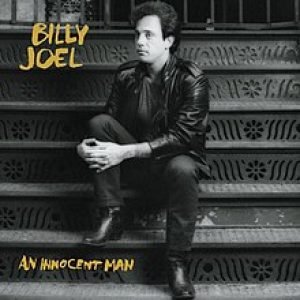Released in 1983, An Innocent Man stands as a unique entry in Billy Joel’s expansive discography, both a nostalgic homage and a creative leap forward. Coming off the massive success of his earlier albums like The Stranger and 52nd Street, which solidified his reputation as one of the most versatile songwriters of the late 20th century, Joel decided to pivot in a different direction. This album diverges from the contemporary rock and pop that dominated his previous works and instead immerses itself in the sounds of the 1950s and early 1960s.
Artistic Intentions
An Innocent Man is, at its core, a love letter to the musical styles that shaped Joel’s youth—the doo-wop harmonies, the Brill Building pop, and the soul ballads that defined an era. It’s a deeply personal project, one where Joel revisits his formative years, not just to reminisce but to celebrate the influences that made him the artist he became. Unlike the introspective or socially conscious themes of his earlier albums, this one focuses on pure musical enjoyment, an exploration of the sounds and sentiments of simpler times.
Joel’s artistic intention with An Innocent Man was clear: to capture the essence of the music he loved as a young man and reinterpret it through the lens of his mature songwriting craft. In interviews, Joel has described the album as a “tribute” and an “experiment,” a chance to step back from the pressures of producing another chart-topping hit and instead indulge in a passion project. The result is an album that feels both refreshing and timeless, a joyful exploration of the past through the eyes of an artist who has mastered his craft.
Sonic Exploration

An Innocent Man is a masterclass in sonic clarity and nostalgia, expertly produced to evoke the sounds of a bygone era while maintaining the high production standards of the 1980s. Phil Ramone, who had already produced some of Billy Joel’s most iconic records, returned to the helm for this album, ensuring that every track was meticulously crafted.
The production is polished, with each instrument and vocal line captured in crisp detail, yet it still manages to convey the warmth and authenticity of the 1950s and 1960s recordings it seeks to emulate. This balance between modern clarity and retro charm is a significant part of the album’s appeal, as it bridges the past and present, allowing listeners to experience the music of yesteryear through a contemporary lens.
Musical Arrangements
The musical arrangements on An Innocent Man are nothing short of brilliant, showcasing Joel’s versatility as both a vocalist and a composer. The album opens with the title track, “An Innocent Man,” where Joel’s voice soars over a sparse piano arrangement that gradually builds into a full orchestral swell, reminiscent of the grand ballads of the early 1960s.
Throughout the album, Joel deftly switches between different vocal styles—crooning with the smoothness of a doo-wop singer on “The Longest Time,” belting out rock ‘n’ roll energy on “Tell Her About It,” and channeling soulful introspection on “Leave a Tender Moment Alone.” The vocal harmonies, particularly on tracks like “The Longest Time,” are a standout feature, meticulously layered to capture the richness of the doo-wop sound, with Joel himself providing many of the harmonized backing vocals.
Genre Elements
In terms of genre exploration, An Innocent Man is a veritable tour of mid-20th-century American music. Joel effortlessly weaves through doo-wop, Motown, rock ‘n’ roll, and pop balladry, paying homage to each genre with sincerity and skill. The album doesn’t attempt to blend these genres in a novel way; instead, it revels in their purity, celebrating the distinctiveness of each style.
“Uptown Girl,” for instance, is a pristine slice of Four Seasons-inspired pop, complete with falsetto vocals and a propulsive rhythm that captures the effervescence of 1960s teenage love songs. Meanwhile, “Keeping the Faith” closes the album with a spirited blend of rock and rhythm and blues, underscoring Joel’s ability to honor the past while keeping the music lively and engaging.
The production quality and musical arrangements on An Innocent Man serve its nostalgic themes perfectly. By marrying the high-fidelity production of the 1980s with the sounds of the 1950s and 1960s, Billy Joel not only pays tribute to the music of his youth but also creates a timeless work that resonates across generations.
Lyrical Analysis

The lyrics of An Innocent Man are imbued with a sense of nostalgia, youthful exuberance, and romantic idealism, reflecting Billy Joel’s introspective journey through the music and experiences of his past. At its core, the album is a celebration of innocence and vulnerability, with Joel exploring themes of love, heartache, and the passage of time. The title track, “An Innocent Man,” sets the tone with lyrics that speak to the universal fear of rejection and the longing for acceptance: “I am an innocent man / Oh yes, I am.” This song, like many others on the album, captures a poignant mix of hope and melancholy, mirroring the complexities of growing up and facing the world with open eyes.
Throughout the album, Joel revisits the emotional highs and lows of youthful love. In “The Longest Time,” he nostalgically reflects on the joys of rekindling a past romance, with lyrics that are both tender and wistful: “If you said goodbye to me tonight / There would still be music left to write.”
The theme of love’s innocence and the idealized past is a recurring motif, as seen in “Uptown Girl,” where Joel paints a picture of unrequited love for a girl from a different world, with lyrics that echo the classic boy-meets-girl narrative of 1960s pop songs. This simplicity and sincerity in storytelling are what give the album its charm, allowing listeners to connect with the emotions conveyed, whether they are experiencing them firsthand or reminiscing about their own past.
Lyrical Depth
Lyrically, An Innocent Man is more straightforward and narrative-driven than some of Joel’s previous works. The album’s lyrics are accessible and direct, often telling clear stories or expressing uncomplicated emotions. This approach aligns with the musical styles Joel emulates on the album, where storytelling and relatable emotions were central to the genres he pays tribute to. While there isn’t the abstract or deeply metaphorical writing found in some of Joel’s earlier albums, the lyrics here carry a depth of feeling that resonates deeply.
In “Leave a Tender Moment Alone,” Joel explores the vulnerability of love and the fear of ruining something beautiful by overthinking it: “Yes, I know I’m in love / But just when I ought to relax / I put my foot in my mouth.” These lyrics, though simple, capture the delicate balance of emotions that accompany love and relationships.
Emotional Impact
The emotional impact of An Innocent Man is undeniable, largely due to the honesty and earnestness of its lyrics. The album evokes a wide range of feelings, from the carefree joy of falling in love in “Tell Her About It” to the introspective melancholy of “This Night,” where Joel reflects on the fleeting nature of time and love. The lyrics contribute significantly to the album’s emotional resonance, grounding the nostalgic musical styles in real, relatable human experiences. Whether invoking the sweetness of first love or the bittersweet memories of youth, Joel’s lyrics on An Innocent Man evoke a deep sense of empathy and connection, allowing listeners to see themselves in the stories he tells.
Cohesion and Flow

An Innocent Man is an album that not only stands as a tribute to the past but also as a testament to Billy Joel’s skill in crafting a cohesive narrative through music. The tracks flow seamlessly from one to the next, creating a listening experience that feels both deliberate and natural. Each song is a distinct vignette, yet together they form a larger story—a nostalgic journey through the emotional landscapes of love, youth, and memory. The progression from one track to another is smooth, with each song building upon the themes and moods of its predecessor, ensuring that the album feels unified despite its stylistic diversity.
The album opens with the title track, “An Innocent Man,” setting an introspective tone that carries through much of the album. This song, with its reflective lyrics and soaring melodies, serves as a prelude to the more upbeat and playful “The Longest Time” and “Uptown Girl,” which follow.
These early tracks establish a sense of youthful exuberance and romantic optimism, evoking the innocence and excitement of first loves and new beginnings. As the album progresses, there’s a subtle shift in tone, with songs like “This Night” and “Leave a Tender Moment Alone” introducing more complex emotions, such as longing and vulnerability. The track progression mirrors the emotional journey from the highs of carefree love to the deeper, more introspective moments that accompany relationships as they mature.
Thematic Consistency
Despite the variety of musical genres and styles explored on An Innocent Man, there is a remarkable consistency in thematic content and emotional tone. The album is unified by its central theme of nostalgia, with each song offering a different perspective on the innocence and idealism of youth. Whether Joel is channeling doo-wop harmonies in “The Longest Time” or the brash energy of rock ‘n’ roll in “Christie Lee,” the album never strays from its core mission of celebrating the music and emotions of the past.
Even the more stylistically distinct tracks, like the soulful “Keeping the Faith” or the jazzy “Easy Money,” are tied together by Joel’s unmistakable voice and songwriting, which imbue each song with a personal touch that keeps the album from feeling disjointed.
There are no jarring shifts in mood or style; rather, the album’s diversity of sound serves to enrich its narrative, offering a well-rounded exploration of its themes. Each track contributes to the overall story, whether it’s the optimistic exuberance of “Tell Her About It” or the reflective melancholy of “This Night.” The consistency in Joel’s lyrical approach and the meticulous production work ensure that, despite the album’s homage to various genres, An Innocent Man feels like a cohesive work. This cohesion not only makes the album an enjoyable listen from start to finish but also allows it to resonate on a deeper emotional level, as the listener is guided through a nostalgic yet emotionally rich journey.
Standout Tracks and Moments
An Innocent Man is filled with memorable tracks, each bringing something unique to the album’s tapestry, but a few stand out for their artistic merit, emotional resonance, and sheer innovation. These tracks not only capture the essence of Billy Joel’s homage to the past but also showcase his exceptional talent as a songwriter and performer.
Key Tracks
One of the most iconic tracks on the album is “Uptown Girl,” a bright, infectious pop anthem that has become one of Joel’s signature songs. Inspired by the music of Frankie Valli and the Four Seasons, “Uptown Girl” stands out for its catchy melody, tight vocal harmonies, and Joel’s impressive falsetto, which perfectly captures the innocence and excitement of unrequited love.
The song’s driving rhythm and upbeat energy make it an instant earworm, and its timeless appeal has ensured its place as one of the most beloved songs in Joel’s catalog. The music video, featuring Joel in a playful role as a mechanic vying for the attention of a glamorous “uptown girl,” further cemented the song’s place in pop culture history.
Another standout track is “The Longest Time,” a doo-wop-inspired ballad that showcases Joel’s ability to create complex vocal arrangements. Performed almost entirely a cappella, with Joel providing nearly all the backing vocals himself, “The Longest Time” is a testament to his vocal versatility and his deep understanding of the genre he’s paying tribute to. The simplicity of the arrangement—just voices and a sparse bass line—allows the emotional sincerity of the lyrics to shine through, making it one of the most touching and memorable moments on the album. The song’s nostalgic lyrics about rekindled love and the yearning for the past resonate deeply, evoking a sense of timelessness and emotional purity.
“This Night” is another highlight, notable for its lush, romantic melody and its unexpected use of a classical motif. Joel borrowed the main theme from Beethoven’s Pathetique Sonata for the chorus, seamlessly blending it with a doo-wop arrangement that is both innovative and emotionally potent. This fusion of classical music with 1950s pop stylings is a brilliant example of Joel’s creative genius, demonstrating his ability to draw from diverse influences and create something entirely new and emotionally resonant. The song’s lyrics, which reflect on the fleeting nature of love and time, add to its emotional depth, making it a standout track that encapsulates the album’s themes of nostalgia and introspection.
Memorable Moments
One of the most memorable moments on the album comes in “Leave a Tender Moment Alone,” where Joel’s voice is complemented by Toots Thielemans’ haunting harmonica solo. The interplay between Joel’s smooth vocals and the soulful harmonica creates a poignant atmosphere, perfectly capturing the delicate emotions expressed in the song’s lyrics. This moment exemplifies Joel’s ability to convey vulnerability and tenderness through both his music and his voice, making it a highlight of the album.
Finally, “Keeping the Faith” stands out as the closing track, both for its upbeat, celebratory tone and its reflective lyrics. The song’s energetic blend of rock, soul, and R&B serves as a fitting finale to the album, with Joel looking back on his youth with a mix of humor and wisdom. The lyrics, filled with playful references to the past, encapsulate the album’s nostalgic spirit, while the infectious groove and dynamic arrangement make it a joyful and uplifting conclusion to the album.
Artistic Contribution and Innovation

An Innocent Man holds a distinctive place within the pop and rock genre, as well as in the broader music industry of the 1980s. At a time when the charts were dominated by synthesizers, new wave, and the burgeoning MTV-driven visual culture, Billy Joel’s decision to craft an album that pays homage to the sounds of the 1950s and early 1960s was both a bold and refreshing move.
Rather than pushing the boundaries of contemporary music or diving into the sonic experimentation that characterized much of the music of the era, Joel chose to look backward, embracing the classic pop structures and musical styles that had largely fallen out of favor. This approach not only set An Innocent Man apart from its peers but also demonstrated Joel’s confidence and mastery as an artist, capable of transcending trends to create a work that resonated on its own terms.
Innovation
In terms of innovation, An Innocent Man is a fascinating study in how an artist can reinvent the past without simply replicating it. While the album adheres closely to the musical norms of the genres it celebrates—doo-wop, Motown, early rock ‘n’ roll—Joel’s fresh take on these styles injects them with new life. The album’s production, under the expert guidance of Phil Ramone, is a perfect blend of retro authenticity and modern polish.
This combination allows An Innocent Man to sound both timeless and contemporary, capturing the warmth and intimacy of vintage recordings while benefiting from the clarity and precision of 1980s studio technology. This production approach was innovative in its ability to bridge eras, making the music accessible to both older listeners who remembered these sounds from their youth and younger audiences who were experiencing them for the first time.
Thematically, the album’s exploration of innocence, love, and nostalgia was also somewhat unconventional in the context of the 1980s music scene, which often leaned towards themes of excess, rebellion, and social commentary. Joel’s focus on the emotional purity of youth and the bittersweet nature of looking back at simpler times was a deliberate contrast to the edgier, more cynical tone of much of the popular music of the day.
This thematic exploration was innovative in its own right, offering a form of introspection that was both deeply personal and universally relatable. By weaving these themes through a variety of musical styles, Joel not only created a cohesive narrative but also challenged the idea that innovation in music must always come from pushing forward. Instead, An Innocent Man proves that looking back can be just as creatively rewarding, especially when done with the level of care and craftsmanship that Joel brings to the album.
Moreover, Joel’s ability to channel his musical influences while still imprinting the songs with his own personality was another key innovation of the album. While each track clearly pays tribute to a specific genre or artist, none of them feel like mere pastiches. Instead, Joel integrates his influences into his songwriting in a way that honors the original while making it unmistakably his own. This balance of reverence and originality is what gives An Innocent Man its lasting appeal, as it transcends the notion of a “concept album” to become a heartfelt and sincere expression of Joel’s musical identity.
In the broader context of Billy Joel’s career, An Innocent Man is a testament to his versatility and willingness to take creative risks. By choosing to diverge from the path laid out by his previous albums, Joel not only expanded his artistic palette but also contributed a unique and enduring work to the pop music canon. While the album may not have been groundbreaking in the conventional sense, its innovation lies in its ability to recontextualize the past, making it feel fresh, relevant, and emotionally resonant for listeners across generations.
Closing Thoughts

An Innocent Man is a shining example of Billy Joel’s ability to blend nostalgia with artistry, creating an album that is as much a tribute to the past as it is a statement of his musical versatility. The album’s strengths lie in its impeccable production, Joel’s skillful navigation of various musical genres, and the heartfelt sincerity that permeates each track. By revisiting the sounds of the 1950s and early 1960s, Joel not only honors the music that shaped him but also invites listeners to partake in a journey through time, evoking emotions that are both deeply personal and universally relatable.
Strengths & Limitations
The album’s standout tracks, such as “Uptown Girl,” “The Longest Time,” and “This Night,” demonstrate Joel’s knack for crafting memorable melodies and poignant lyrics, while the overall cohesion of the album ensures that it feels like a unified and carefully curated work. The thematic consistency—centered around love, innocence, and the passage of time—adds depth to the listening experience, making An Innocent Man more than just a collection of songs, but a cohesive narrative that resonates long after the final track fades.
However, while the album’s adherence to classic pop styles is one of its strengths, it could also be seen as a limitation. Some listeners might find that An Innocent Man doesn’t push the boundaries of musical innovation as much as Joel’s earlier works, such as The Stranger or 52nd Street. The focus on nostalgia and tribute, while beautifully executed, may not appeal to those looking for more groundbreaking or forward-thinking music.
Despite this, An Innocent Man stands out as one of Billy Joel’s most beloved and enduring albums. Its ability to evoke the spirit of a bygone era while maintaining a fresh and engaging sound has ensured its place as a classic in his discography. For fans of Joel’s work, the album offers a deep dive into the music that inspired him, presented with all the polish and craftsmanship that one would expect from an artist of his caliber.
In terms of its impact on listeners, An Innocent Man has the power to transport, to comfort, and to evoke a sense of nostalgia that is both sweet and bittersweet. It’s an album that invites repeated listens, with each track offering something new to discover, whether it’s a clever lyric, a subtle harmony, or a perfect instrumental flourish.
Official Rating
Given its strengths in production, arrangement, and emotional resonance, I would rate An Innocent Man a solid 9 out of 10. While it may not break new ground in the way some of Joel’s other albums do, its execution is near flawless, and its appeal is enduring. This album is a testament to Billy Joel’s mastery as a songwriter and performer, and it remains a cherished work in his catalog—one that continues to resonate with listeners across generations.
